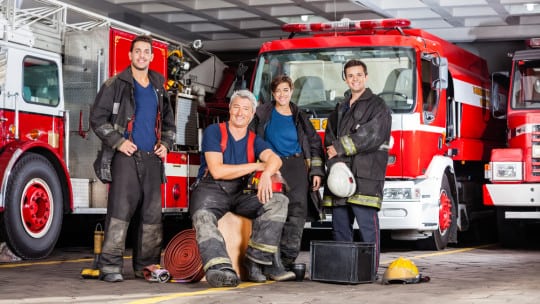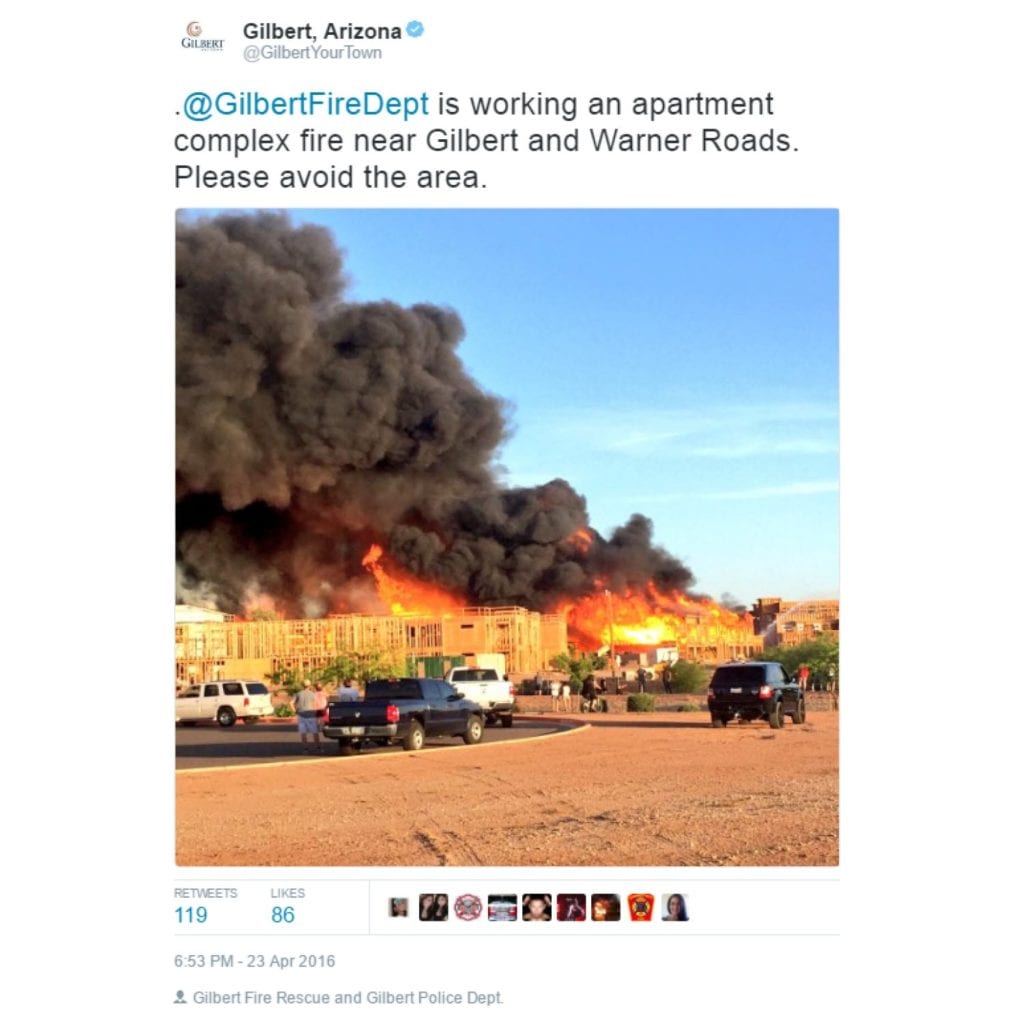


Has your organization been hit with a crisis? As a PR pro, you understand it’s not a matter of if, but when. As a result, preparedness, including having a crisis communications plan, is essential to ensure a timely response.
When a massive five-alarm fire broke out on a Saturday evening in busy Gilbert, Arizona, a Phoenix suburb home to nearly 250,000 residents, the Gilbert Fire and Rescue Department partnered with Gilbert’s Digital Communications Department to take a teamwork and technology approach to communication and community outreach.
This mini case study is an example of how an incident can continue to grow with time and how your response should, too. What started as a small fire at an apartment complex under construction quickly turned into a conflagration that threatened nearby homes, a 120-unit apartment complex, several businesses and Gilbert’s municipal buildings. The situation resulted in evacuations, road closures, panic and tremendous curiosity as flames could be seen for miles across the Phoenix valley. Nearly 140 firefighters from multiple city agencies battled the blaze for more than five hours to stop it from spreading and potentially gutting an entire city block.
During this time our team was challenged with managing the news media, social media and community outreach. As mentioned above, preparedness is key in situations like this and with our crisis communications plan in place we were effectively able to become our own news agency to communicate the most up-to-date information to residents and the media. In fact, we had nearly 30,000 people following as Gilbert and the fire were trending with Beyoncé on Twitter.

Here are four key parts of Gilbert’s crisis communications plan that we believe your brand can consider, too.
1. Be a News Agency. It’s not a secret that the news media continues to shrink and news agencies are running with minimal staff. With this in mind, it’s very important to be your own news agency and tell your story. You are the source and your residents will come directly to you for the most up-to-date and factual information. In addition, can anyone tell your story better than you?
The fire occurred at about 6 p.m. on a Saturday, not prime time for the media. This gave us the opportunity to be the source of information for residents and those looking for anything about the fire. We got ahead of the news stations and told our story live on social media before they went on air for the regular 10 p.m. news broadcast.
It’s vital to build your following before a crisis hits so that when you need to distribute important information, your followers already are engaged. Plus, by consistently telling your story, the good and the bad, you build trust and credibility. And the best part is that technology is making it easier to tell your story, which brings us to our next point…
2. Embrace It. Technology is rapidly changing and is giving PR and marketing pros new outlets to reach and engage followers and customers. Embracing new tools and incorporating them into your communications plan, and more importantly, your crisis communications plan, is critical.
Find out where your customers are and use that platform(s), whether Twitter, Facebook Live, Instagram, Snapchat or a future social media platform, to share information before, during and after crisis situations.
It seems obvious, but make sure customers know where to find you and the information they seek. Gilbert has more than 25 social media channels, but during emergencies Twitter is our primary social platform to convey up-to-date information.
In addition to Twitter, we also used live video (see sidebar), and in this case, Persicope, to give the community an opportunity to see the scene and hear from and engage in a two-way conversation with Gilbert Fire’s public information officer. We went live from the fire twice; the first time was before mass media coverage began and the second live segment competed with 10 p.m. newscasts.
During the fire, our social media updates included information on evacuations, road closures, media staging areas and status updates. Twitter also gave us an opportunity to show a behind-the-scenes look. We were able to tell the full story, from the firefighters battling the blaze to the rehab they needed when they returned from the front lines. Twitter also gave us the opportunity to thank local businesses that provided food for first responders and evacuees as well as neighboring cities that offered additional resources.
This storytelling power allowed us to continually engage our audience and provide a human perspective to the narrative. It also gave citizens an opportunity to connect with first responders and thank them for their effort.
3. No Solos.During a major incident, such as a five-alarm fire, there are a lot of moving parts. Here’s a checklist from the fire that you can modify to your needs:
- Manage onsite media
- Handle phone and email media inquiries
- Gather the latest information
- Share the above information
- Monitor the media and social conversation
As you can guess, this is far from an exhaustive list. The point is crisis management is a team sport. You can’t do it alone. It’s important to build your crisis communications SWAT team before you need it. Waiting for a crisis to occur before deciding who will do what can be a recipe for disaster.
During the fire we had four staffers assisting with crisis communications and outreach. Three were onsite: One handled media interviews, another assisted with phone-interview requests and the third was working on social media while also gathering the latest details. The fourth was offsite monitoring news coverage and assisting with social listening. We found social listening was important because it clued us into how our message was being received and what parts of it either the media or we were failing to convey.
Had the fire worsened, our crisis communications plan outlines additional resources to be deployed. By planning ahead and having your team in place, it makes coordinating communications during a crisis as seamless as possible.
4. Provide Information, Not Perfection.In a crisis, timing is everything. It is important to get ahead of the incident and establish yourself as the source of information. Crisis situations are evolving constantly and changing, sometimes by the minute. Your audience does not expect perfection, but it does expect and need information.
As soon as we are aware of a crisis situation, we make it a priority to post about it immediately on social media, specifically Twitter. If we lack many details, at minimum we recognize that there is an incident and let our followers know more information will be posted as soon as it is available. The fact that we at least recognize that there is an incident has helped to build credibility with our citizens.
We believe Gilbert’s crisis communications plan can serve as a model for government communicators. There were more than 16,000 tweets posted about Gilbert and the Gilbert Fire, which, as we noted above, led to the topic trending with Beyoncé and the UFC on Twitter. People near and far were talking about the fire and we were leading that global conversation. Gilbert’s tweets had more than 30,000 impressions and Gilbert Fire and Rescue’s Twitter account gained an additional 700 followers. Citizens used social media as a channel to thank first responders and it was an incredible way to bring the community together during a tragedy. All of this was made possible by embracing technology and teamwork during a crisis situation.
CONTACT: [email protected] [email protected]
Three Lessons Learned About Live Video
Live video can be an amazing resource, especially during a crisis. It not only allows you to show a scene but also provides an organization with the opportunity to put a face at the apex of a situation.
There are several options for going live, including Facebook Live, Periscope and YouTube. Even Instagram now has a live video feature. Before you go live, here are some things you should know:
It’s the ultimate multitasking challenge. This is something you won’t necessarily understand until you try it. This is why practicing using live streaming prior to going live at an event, especially during a crisis, is imperative. When you’re live, not only should you be emphasizing talking points, providing information or conducting an interview, but you also need to make sure you, or someone, is monitoring questions and comments. Engaging in a two-way conversation with viewers is the best way to connect with them. Bonus tip: Turn off all other notifications while you go live to prevent them from interrupting your live feed.
“Haters gonna hate.” Just as with any other social media platform, live video gives viewers the freedom to say what they wish. Depending on your organization’s policies, you can block them, or if you can’t block them, encourage appropriate comments throughout your broadcast. More often than not, other viewers will end up policing the naysayers.
Technology is draining. The great thing about technology is that you’re now able to do nearly everything from your smartphone. When you’re managing crisis communications from your phone, your device is going to be working overtime, so it’s important to make sure you not only have a full battery when you start, but that you also have a charger. This is especially important when you go live. Live broadcasts tend to drain smartphone batteries even faster and you will not know how long your emergency situation will last. The worst thing you can do is run out of battery power in the middle of a live stream.
